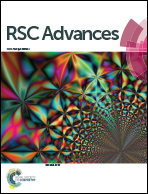Probing solvent–solvent and solute–solvent interactions in surfactant binary mixtures: solvatochromic parameters, preferential solvation, and quantum theory of atoms in molecules analysis†
Abstract
The behaviour of solvatochromic absorbance probes (4-nitroaniline, 4-nitroanisole, and Reichardt's dye) within binary mixtures of polyethylene glycol p-(1,1,3,3-tetramethylbutyl)-phenyl ether (Triton X-100 or TX-100)/organic solvents (2-propanol, hexanol, butyl acetate, THF, toluene, and p-xylene) was extensively explored by using solvatochromism and the quantum theory of atoms in molecules (QTAIM). To be more precise, the polarity parameters, ENT, and Kamlet–Taft parameters, such as the hydrogen bond donor ability (HBD) (α), hydrogen bond acceptor ability (HBA) (β), and dipolarity/polarizability (π*), have been investigated in selected mixtures at 298 K. All binary mixtures exhibit complex behavior for chosen probes. The results indicate that 4-nitroanisole and Reichardt's dye have stronger interactions with binary mixtures of alcohols/TX-100. The interaction energies decreased in the following order: butyl acetate > hexanol ∼ 2-propanol > THF > p-xylene ∼ toluene. The preferential solvation model was applied to provide insight into the nature of solute–solvent and solvent–solvent interactions in these binary mixtures. Specific solute–solvent and solvent–solvent interactions are believed to be responsible for deviation from ideality.


 Please wait while we load your content...
Please wait while we load your content...